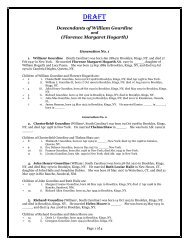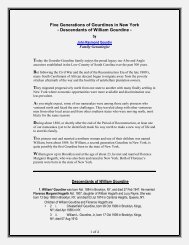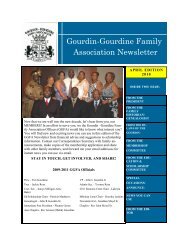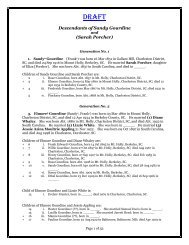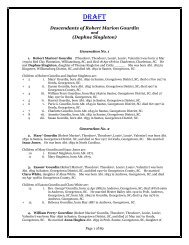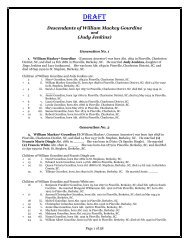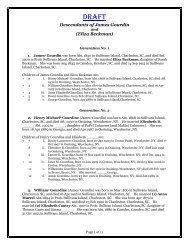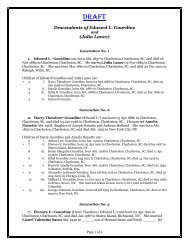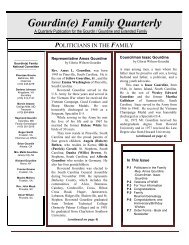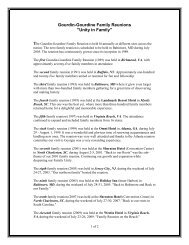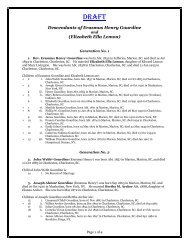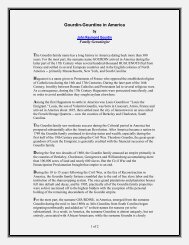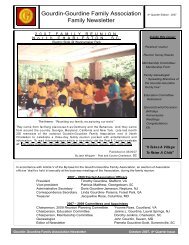Gourdin-Gourdine of Charleston - Ggfa.org
Gourdin-Gourdine of Charleston - Ggfa.org
Gourdin-Gourdine of Charleston - Ggfa.org
You also want an ePaper? Increase the reach of your titles
YUMPU automatically turns print PDFs into web optimized ePapers that Google loves.
<strong>Gourdin</strong>-<strong>Gourdin</strong>es <strong>of</strong> <strong>Charleston</strong><br />
Important Influence on City and Surrounding Area<br />
by<br />
John Raymond <strong>Gourdin</strong><br />
Family Genealogist<br />
On your next visit to <strong>Charleston</strong>, South Carolina, you should take advantage <strong>of</strong> the<br />
opportunity to explore the downtown area and become acquainted with the residents and<br />
activities <strong>of</strong> our ancestral kinsfolk who were, in part, the builders and developers <strong>of</strong><br />
<strong>Charleston</strong>. If you've never visited <strong>Charleston</strong>, then you should place this high on your<br />
priority list <strong>of</strong> things to do. This article will provide you with some historical and<br />
genealogical information that, hopefully, will help make your next visit to <strong>Charleston</strong>,<br />
and the surrounding area, a more enjoyable and rewarding experience.<br />
<strong>Gourdin</strong>'s Early Beginnings in <strong>Charleston</strong><br />
The City <strong>of</strong> <strong>Charleston</strong> was established in 1670, and almost from the beginning the<br />
<strong>Gourdin</strong> family has played an important role in the economic and social development <strong>of</strong><br />
<strong>Charleston</strong> District (now <strong>Charleston</strong> and Berkeley Counties) and the surrounding area.<br />
The original <strong>Gourdin</strong> (Louis the Emigrant) was a Huguenot who emigrated from France<br />
during 1693-95. During the 1500s and 1600s Huguenots were persecuted mercilessly by<br />
leaders <strong>of</strong> the Catholic Church so, during the latter part <strong>of</strong> the 1600s several hundred<br />
thousands Huguenots fled France in search <strong>of</strong> freedom and a new way <strong>of</strong> life.<br />
Prior to the American Revolution (1775-83), the <strong>Gourdin</strong>s were awarded vast grants <strong>of</strong><br />
land from the Colonial Government, and with the aid <strong>of</strong> slave laborers they accumulated<br />
great wealth growing rice and indigo. By the time <strong>of</strong> the Civil War (1861-65) the <strong>Gourdin</strong><br />
family was one <strong>of</strong> the wealthiest families in South Carolina, owning nearly 200,000 acres<br />
<strong>of</strong> land and more than 600 slaves.<br />
Coming Street – a Haven for <strong>Gourdin</strong>e-<strong>Gourdin</strong>es <strong>of</strong> African Descent<br />
During the early 1800s, Theodore <strong>Gourdin</strong> (born 1765) was the patriarch <strong>of</strong> the <strong>Gourdin</strong><br />
family. He was the great-grandson <strong>of</strong> Louis the Emigrant. It is highly probable that all<br />
<strong>Gourdin</strong>s and <strong>Gourdin</strong>es, with origin in the low country <strong>of</strong> South Carolina area, are<br />
descended from the Theodore <strong>Gourdin</strong> extended family or from slaves owned by the<br />
family.<br />
During the late 1800's and early 1900's a great number <strong>of</strong> <strong>Gourdin</strong>-<strong>Gourdin</strong>es <strong>of</strong> African<br />
decent resided in and around the City <strong>of</strong> <strong>Charleston</strong>. Those who resided in the rural area<br />
around the City were usually farmers who either owned their farms or were employed as<br />
farmers or field hands. <strong>Gourdin</strong>-<strong>Gourdin</strong>e men who resided in the city participated in a<br />
variety <strong>of</strong> occupations including - barber, carpenter, cook, laborer, painter, and waiter,<br />
while women were usually employed as cook, babysitter, housekeeper, and seamstress.<br />
A fair number <strong>of</strong> the men were employed in pr<strong>of</strong>essional jobs. For example, during, at<br />
least the 1860s, Rev Erasmus <strong>Gourdin</strong> was the pastor <strong>of</strong> the Graham Chapel Church. He<br />
resided with his family at 222 Coming Street. Donald Fraser who attended our Virginia<br />
Beach reunion in 1997 is the great-grandson <strong>of</strong> Erasmus. Erasmus died on July 14, 1893,<br />
1 <strong>of</strong> 3
GG-America<br />
(cont’d)<br />
and is buried at Zion Cemetery near <strong>Charleston</strong>; and during 1888 to 1926, Edward<br />
<strong>Gourdin</strong>e was employed by the Chasm D D & M Company and for Riverside Iron Works<br />
as a ship carpenter. He resided with his wife Maggie and family at 93 Comings Street<br />
(and other places over time). Edward died on August 20, 1928.<br />
Also, during 1909-1930, Samuel <strong>Gourdin</strong>e was employed with the Anderson Lumber<br />
Company, progressing from a laborer to the position <strong>of</strong> foreman. He resided with his wife<br />
Elizabeth and family at 14 Kirkland Lane and later at 55 Coming Street<br />
Likewise, a good number <strong>of</strong> <strong>Gourdin</strong>-<strong>Gourdin</strong>e women were employed in pr<strong>of</strong>essional<br />
jobs. Amelia, Julia, Mamie, and Matilda <strong>Gourdin</strong> were employed or worked<br />
independently as seamstresses; Ester <strong>Gourdin</strong> was a bookkeeper and resided at 20<br />
President Street; and Julia, Letsy, Ruth and Mattie <strong>Gourdin</strong> were school teachers. Julia<br />
was a teacher at the prestigious Avery Institute. The Institute is still functioning until<br />
today and is the best source <strong>of</strong> information on Black life in <strong>Charleston</strong>.<br />
Life in “Colored Communities” in Downtown <strong>Charleston</strong><br />
<strong>Gourdin</strong>-<strong>Gourdin</strong>es resided throughout the City <strong>of</strong> <strong>Charleston</strong>, but mostly in the<br />
downtown portion <strong>of</strong> the city. The names <strong>of</strong> many <strong>of</strong> the streets where our kinship<br />
resided more than a hundred years ago are still in use today - Calhoun, Cannon, Church,<br />
Coming, Congress, Duncan, King, Laurens, Line, Nassau, Pitt, President, Queen,<br />
Rutledge, and Tradd. Most <strong>of</strong> the <strong>Gourdin</strong>-<strong>Gourdin</strong>es <strong>of</strong> African decent resided in areas<br />
referred as colored communities. One these communities was centered around the<br />
intersection <strong>of</strong> Coming and Calhoun streets where more than a dozen <strong>Gourdin</strong>-<strong>Gourdin</strong>e<br />
families resided during the latter part <strong>of</strong> thee 1800s.<br />
In 1871, Robert and Daphney (Singleton) <strong>Gourdin</strong> resided a 2 College Street, near the<br />
intersection <strong>of</strong> College and Calhoun streets - one block east <strong>of</strong> Coming Street. Robert was<br />
the son <strong>of</strong> Theodore and Daphney was his mulatto concubine. They had at least seven<br />
children – four boys and three girls. Two <strong>of</strong> the boys, William and Paris, are the ancestors<br />
<strong>of</strong> most <strong>of</strong> the <strong>Gourdin</strong>-<strong>Gourdin</strong>es from Ge<strong>org</strong>etown and Williamsburg counties –<br />
specifically the Oceda area.<br />
Some other kinfolk who resided in <strong>Charleston</strong> during the latter part <strong>of</strong> the 1800s were<br />
William <strong>Gourdin</strong> who was a baker with the E.F. Bose Company. He resided at 643<br />
Coming Street; and David <strong>Gourdin</strong>e who was employed as a coachman for Dr. H. B.<br />
Horlbeck. He resided at 113 Wentworth Street.<br />
During the early years <strong>of</strong> the 1900s Arthur <strong>Gourdin</strong>e was employed by the Molony &<br />
Carter Company and resided at 14 Alexander Street with his wife Ellen; Amelia<br />
<strong>Gourdin</strong>e earned a living as a dressmaker, working from her residence at 60 Mill Street;<br />
Frank <strong>Gourdin</strong>e was a foreman with A. F. Pringle & Company. He resided at 45 Line<br />
Street; and James <strong>Gourdin</strong>e was employed by the Logan-Robinson Fert[ilizer]. He<br />
resided with his wife Lillian and his family at 76 Washington Street.<br />
Further, during 1948, Alexander <strong>Gourdin</strong>e was employed as a ship fitter at the<br />
<strong>Charleston</strong> Navy Yard, and resided with his wife Florence at 60 Mill Street, within a<br />
short walking distant from the Navy shipyard.<br />
2 <strong>of</strong> 3
GG-America<br />
(cont’d)<br />
Legacy <strong>of</strong> <strong>Gourdin</strong>-<strong>Gourdin</strong>es and Extended Families Remains Strong Today<br />
Most <strong>of</strong> these street names are still in use today. Coming Street where a good number <strong>of</strong><br />
<strong>Gourdin</strong>-<strong>Gourdin</strong>e families resided, is still a prominent street and stretches more than<br />
twenty blocks and runs right down the middle <strong>of</strong> downtown <strong>Charleston</strong>.<br />
Today many <strong>Gourdin</strong>-<strong>Gourdin</strong>e families reside in <strong>Charleston</strong> and the immediate<br />
surrounding area. A few examples are: Alfred & Mable <strong>Gourdin</strong>e, 1940 Grimball Road,<br />
James Island; John & Carol <strong>Gourdin</strong>, 1350 Roddington Street, Mt. Pleasant; Virginia<br />
<strong>Gourdin</strong>, 14 Tradd St, <strong>Charleston</strong>; Andrea <strong>Gourdin</strong>e, 1838 Grimball Rd, James Island;<br />
Kent & Susan <strong>Gourdin</strong>, Mt. Pleasant; and Sidney & Tieshka <strong>Gourdin</strong>e, 7925 Saint Ives<br />
Road, <strong>Charleston</strong>.<br />
In all, more than 100 households in South Carolina are headed by a <strong>Gourdin</strong>-<strong>Gourdin</strong>e.<br />
When households headed by members <strong>of</strong> our extended family are included in the count<br />
this number can easily be tripled or quadrupled. Of these households, more than seventyfive<br />
percent reside within twenty-five miles <strong>of</strong> Downtown <strong>Charleston</strong>. So this is indeed<br />
an excellent time to make and renew acquaintances during our visit to <strong>Charleston</strong>.<br />
Many <strong>of</strong> the cemeteries in the <strong>Charleston</strong> area where <strong>Gourdin</strong>s(e) were laid to rest<br />
include - Bonneau, Calvary, Centenary, Emanuel and Monrovia. The Old Bethel United<br />
Methodist, established in 1807; Emmanuel AME; Louis Christian; Friendly Union<br />
Society; Fielding's Brown; Humane and Friendly; Unity and Friendship Society;<br />
Brotherly Association, established in 1856; Old Emmanuel; Old Morris Brown; Reserved<br />
Fellowship; Morris Brown; and Trinity AME.<br />
So during your leisure time when you decide to visit downtown <strong>Charleston</strong>, be sure to<br />
take a stroll along some <strong>of</strong> the streets where some <strong>of</strong> our kinship strived and prospered<br />
more than a hundred years ago.<br />
EXCERPT: <strong>Gourdin</strong>-<strong>Gourdin</strong>e Quarterly Newsletter<br />
3 <strong>of</strong> 3




